#Carl Gustaf Mannerheim
Text
Oikeesti oon niin vihanen siitä, että Tampereella on patsas Mannerheimista. Siitä tyypistä, joka tunnetusti johti Valkosia ja soti Tampereella, työläiskaupungissa, Punasia vastaan. Ja sitten kun voitti siitä pystytettiin helvetin patsas ihan vaan vittuiluks.
#mannerheim puolustajat dni#suomitumblr#suomitumppu#suomi#suomipaskaa#politiikka#vittu#saatana#perkele#carl gustaf emil mannerheim#oon myös vihanen siitä että suomen kuvalehti sano sitä 'homoikoniks'#se on vittu porvaripaskaa#kukaan itteensä kunnioitava homo ei ihaile sitä
24 notes
·
View notes
Photo

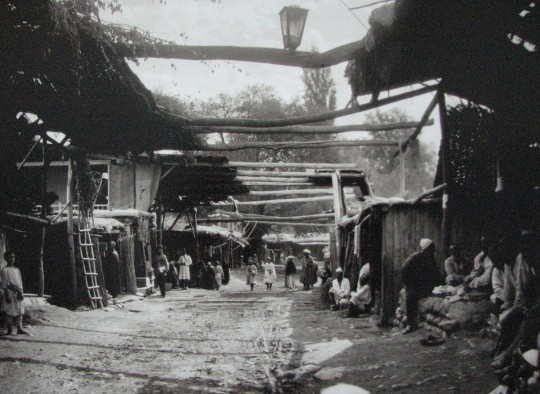
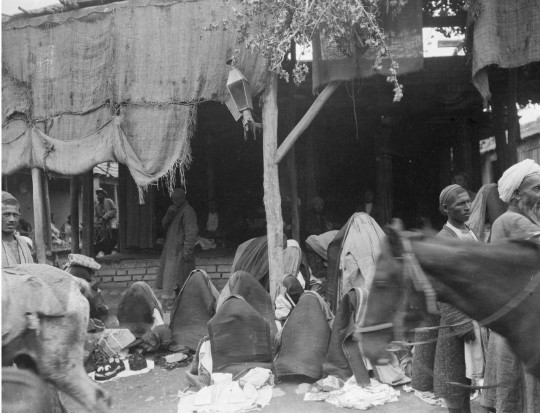
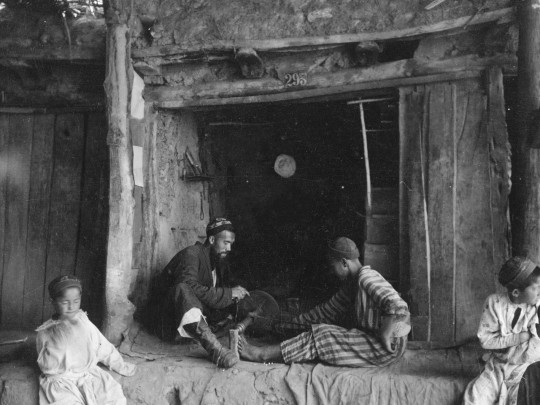
The central bazaar in Osh, Kyrgyzstan, photographed by Carl Gustaf Emil Mannerheim, 1906. Today, as it has for centuries, the bazaar remains along the bank of the Ak-Buura river. (source)
44 notes
·
View notes
Text
Tiny Stories for Finnish Learners: Helsinki
This is from a book I bought! They recommend going through the finnish text once without searching for words, then trying to understand, then check the translation 💚 Same for the comprehension questions!
Aurinko oli laskemassa Helsingin ylle, kun kävelin kadulla. Kaupunki oli niin kaunis vanhoine rakennuksineen ja mukulakivikatuineen. Minusta tuntui kuin olisin ollut eri maailmassa. Käänyin kulman takaa ja näin taidegallerian kyltin. Päätin mennä sisään, koska rakastan taidetta. Galleria oli pieni, mutta siellä oli todella uskomattomia maalauksia esillä. Yksi maalaus kiinnitti erityisesti huomioni; siinä oli nainen kävelemässä kukkapellon läpi. Se näytti niin rauhalliselta ja seesteiseltä. Päädyin viettämään galleriassa tunteja ihaillen kaikkia taideteoksia. Kun lopulta lähdin, ulkona oli jo pimeää.
Kun kävelin takasin hotellille, en voinut olla tuntematta kiitollisuutta tästä upeasta kaupungista ja kaikesta siitä, mitä sillä on tarjota. Seuraavaana päivänä heräsin aikaisin ja päätin tutkia Helsinkiä lisää. Kävelin jonkin aikaa ympäriinsä, ihailin arkkitehtuuria ja katselin nähtävyyksiä. Lopulta päädyin Senaatintorille, jossa on joitakin Helsingin tärkeimpiä rakennuksia. Olin juuri lähdössä, kun näin ryhmän ihmisiä kerääntyvän jonkin ympärille. Menin katsomaan, mistä oli kyse, ja näin, että he katselivat hevosella ratsastavan miehen patsasta. Miehen nimi oli Carl Gustaf Emil Mannerheim, ja hän oli merkittävä henkilö Suomen historiassa. Jäin sinne hetkeksi kuntelemaan tarinoita, joita ihmiset kertoivat hänestä. Oli kiehtovaa oppia ihmisestä, jolla oli niin suuri vaikutus tähän maahan.
Vietettyäni jonkin aikaa torilla päätin käydä syömässä jotain. Löysin söpön pienen kahvilan ja tilasin kupin kahvia ja leivoksen. Kun istuin nauttimassa välipalaa, huomasin, että ohi käveli joukko ihmisiä kameroiden kanssa. He olivat selvästi turisteja. Sain yhtäkkiä idean; miksi en esittelisi heille Helsinkiä? Söin ruokani loppuun ja lähestyin ryhmää. He olivat iloisia siitä, että joku näytti heille paikkoja, joten vietimme loppupäivän tutustuen kaupunkiin yhdessä. Kävimme kaikenlaisissa paikoissa, kuten kirkoissa, museoissa ja jopa huvipuistossa! Päivä oli niin hauska, ja olen varma, että he muistavat Helsingissä viettämänsä ajan aina minun ansiostani.
Translation and comprehension questions under the read more!
As I walked back to my hotel, I couldn't help but feel grateful for this amazing city and all that it has to offer. I woke up early the next day and decided to explore more of Helsinki. I walked around for a while, admiring the architecture and taking in the sights. I eventually made my way to Senate Square, which is home to some of the most important buildings in Helsinki. I was just about to leave when I saw a group of people gathered around something. I went over to see what was going on and saw that they were looking at a statue of a man on a horse. The man's name was Carl Gustaf Emil Mannerhein, and he was an important figure in Finnish history. I stayed there for a while, listening to the stories that people were telling about him. It was fascinating to learn about someone who had such an impact on this country.
The sun was setting over Helsinki as I walked down the street. The city was so beautiful, with its old buildings and cobbleston streets. I felt like I was in a different world, I turned a corner and saw a sign for an art gallery. I decided to go in since I love art. The gallery was small but had some really incredible paintings on display. One painting in particular caught my eye; it was of a woman walkin through a field of flowers. It looked so peaceful and serene. I ended up spending hours at the gallery, admiring all of the artwork. When I finally left, it was dark outside.
After spending some time at the square, I decided to get something to eat. I found a cute little café and ordered a cup of coffee and a pastry. As I sat there enjoying my snack, I noticed a group of people walking by with cameras. They were obviously tourists. I suddenly had an idea; why not show them around Helsinki? I finished my food and then approached the group. They were happy to have someone show them around, so we spent the rest of the day exploring the city together. We went to all sorts of different places, including churches, museums, and even an amusement park! It was such a fun day and I'm sure they'll always remember their time in Helsinki thanks to me.
Mitä kijailija teki saapuessaan Helsinkiin?
Ymmärtämisen kysymykset
Mitä mieltä kirjailija oli kaupungista?
Mitä kirjailija teki nähdessään taidegallerian kyltin?
Mikä oli kirjailijan suosikkitaulu galleriassa?
Miltä kirjailijasta tuntui, kun hän lähti galleriasta?
Mitä kirjailija teki seuraavana päivänä?
Minne kirjailija meni toisena päivänä?
Mitä kirjailija näki ollessaan Senaatintorilla?
Mitä kirjailija teki, kun hän sai idean näyttää turisteille paikkoja?
Missä paikoissa kirjailija ja turistit kävivät?
Comprehension Questions
What did the author do when she first arrived in Helsinki?
What did the author think of the city?
What did the author do when she saw the sign for the art gallery?
What was the author's favourite painting in the gallery?
How did the author feel when she left the gallery?
What did the author do the next day?
Where did the author go on the second day?
What did the author see when she was at Senate Square?
What did the author do when she had the idea to show the tourists around?
What places did the author and the tourists go to?
43 notes
·
View notes
Note
Lemme guess, Alexander the Great was black too. Along with Cleopatra and Queen Charlotte
Can't forget Anne Boleyn, Sir Lancelot, Julius Ceasar, Heimdall, Frier Tuck, Sir Bedivere, Achilles, Joan of Arc, Zeus, Margaret of Anjou, Guinevere, Robert de Beaumont, Carl Gustaf Emil Mannerheim, I can go on.
19 notes
·
View notes
Photo
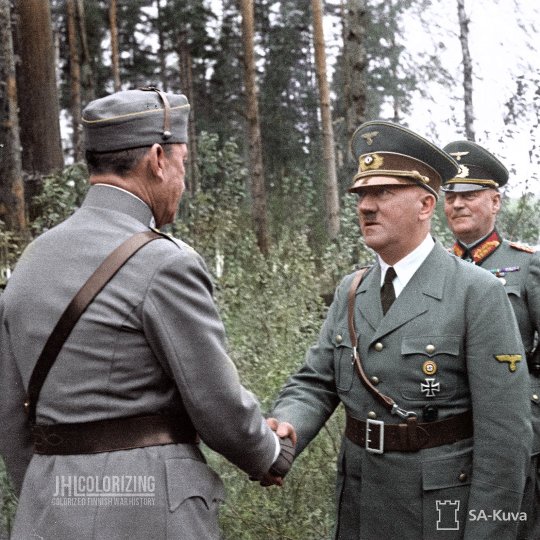
Today we celebrate the Flag Day of the Finnish Defence Forces and birthday of C.G.E Mannerheim.
Exactly 81 years ago today, Adolf Hitler visited Imatra in southeast Finland on the occasion of the 75 birthday of Marshall Carl Gustaf Mannerheim.
••••••••
Tänään vietetään puolustusvoimain lippujuhlan päivää ja Suomen Marsalkka Mannerheimin syntymäpäivää.
Tasan 81 vuotta sitten Adolf Hitler vieraili Imatralla Marsalkka Mannerheimin 75-vuotissyntymäpäivillä. Paikaksi valittiin Kaukopään tehtaan sivuraide Imatralla.
••••••••
[ sa-kuva | 89660 ]
#ww2#wwII#WWII History#wwiihistory#worldwar2#worldwarii#worldwar#worldwartwo#finland#ww2finland#war#jatkosota#sotahistoria#history#historia#war history#continuation war#continuationwar#ww2 continuationwar#hitler#Mannerheim#colorized#colorizing#colourised#colourized#Suomi#suomisodassa
19 notes
·
View notes
Photo


The Finnish tailed state flag and The flag of the President of the Republic of Finland
The swallow-tailed national flag, which is also the naval ensign, is flown by the Finnish Defence Forces.
The presidential standard and the command signs of the Minister of Defence, Chief of Defence, and Commander of the Finnish Navy are flown only by the respective persons. The flag has a Cross of Liberty, 3rd Class on its upper left corner.
The President of Finland is the Grand Master of the Order of the White Rose of Finland and of the Order of the Lion of Finland, and usually of the Order of the Cross of Liberty as well, Grand Mastership of which is attached to the position of Commander-in-chief.
The Order of the Cross of Liberty was founded on March 4, 1918, upon the initiative of Carl Gustaf Emil Mannerheim. The Finnish artist Akseli Gallen-Kallela was commissioned to design the Order's insignia with the Old-Scandinavian Fylfot.
19 notes
·
View notes
Photo
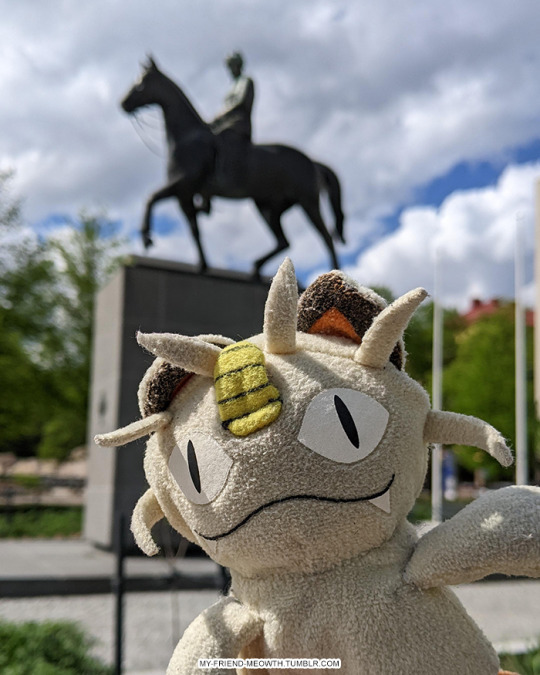
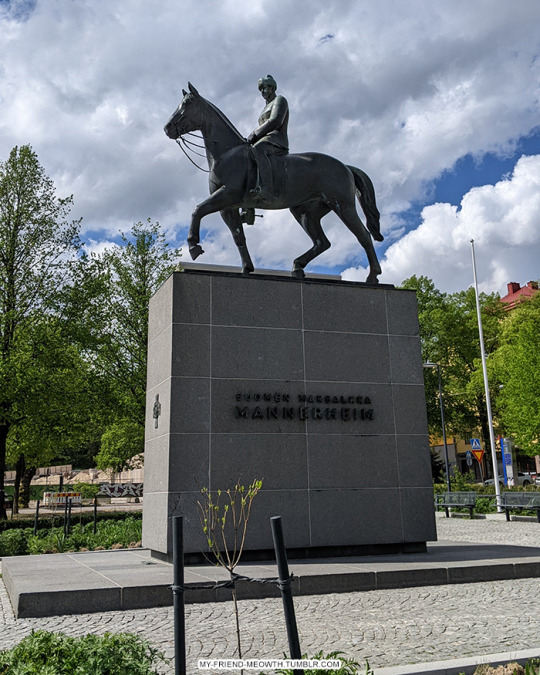
Statue of Carl Gustaf Emil Mannerheim (4 June 1867 – 27 January 1951, Finnish military leader and statesman). Sculpted by Veikko Leppänen, revealed December 19th 1959.
11 notes
·
View notes
Text
Posters have appeared in Moscow defaming the Swedish children's book author Astrid Lindgren as a Nazi. That said, Hufvudstadsbladet (siirryt toiseen palveluun) reports that Finland will likely see similar influence campaigns as Russia attempts to justify its actions in Ukraine.
A Swedish military expert told HBL that Carl Gustaf Emil Mannerheim, Finland's most famous military leader, and longtime president Urho Kekkonen were likely candidates for smear campaigns aiming to cast a shadow on Finland.
A Russian troll factory has meanwhile set its sights on targets in the Finnish media following a call for action by the Russian Ministry for Foreign Affairs.
Summer holiday issue
With Finland's largest cities in the middle of a weeklong school strike, Helsingin Sanomat (siirryt toiseen palveluun) asks whether summer vacation could be pushed back by a week to offset days lost during the teachers' industrial action.
Outi Salo, who heads Helsinki's basic education department, told HS that while the capital does not have any plans to extend the school year, administrators will evaluate whether it's justifiable to keep kids in class after 4 June once the strike ends on 9 May.
By law, the Finnish academic year has 190 working days, with schools typically finishing the spring semester at the start of June.
Beating inflation?
More than a million taxpayers in Finland pay too much income tax. Many people tend to believe that it's better to expect a refund than end up owing back taxes.
Business daily Kauppalehti (siirryt toiseen palveluun)'s most-read story, however, suggests that it's sometimes more profitable for taxpayers to owe the tax office money than to overpay and wait for a refund.
KL reports fintech service company Vertaa Ensin finding that it made the most financial sense to owe just under 1,000 euros in taxes at the end of the tax year. Amounts below this threshold will not accrue late payment interest. The tax office pays 0.5 percent interest on refunds, which is less than the rate of inflation, the business daily writes.
4 notes
·
View notes
Text
4 Finnish History
Finnish Declaration of Independence
On December 6, 1917, Finland declared their independence from Russia, as an independent republic. Before this, they were considered a Grand Duchy of Russia, which the Finns were done with. In 1917, there were two revolutions, between Finland and Russia, which resulted in Finland becoming a sovereign state. On December 18, the Soviet Union agreed with the declaration, and Finland was free.
This sovereignty for Finland was an excellent thing for the people of Finland. Their independence happened mostly because Finland just wanted to be free of a higher power, and wanted to rule themselves. As a grand Duchy, Finland was given a lot of power, but when the Senate gave its proposal to the parliament, independence was signed for Finland.
Their identity was forged by this independence. They became one nation, which was then quickly broken when there was a civil war between the two political parties. The independence, and the civil war, truly forged Finland into the country it is today.
Finnish Civil War
From January 27 to May 15, 1918, there was a civil war between the 2 political parties of Finland. The “Red” side was the social democrats, led by the People’s Deputation of Finland, and supported by the USSR. The “White” side was made up of the non-socialist Senate, led by the previous Tsarist general, Carl Gustaf Emil Mannerheim, and supported by the German empire. This Civil War was fought to secure the control of the newly independent state. The Civil War was high in casualties, but not from battle. Most of the 37,000 people who died, died in the prison camps of the opposing side, and terror campaigns.
This Civil War created economic turmoil. After the Civil War, which was won by the Whites, the Reds were still a part of the political sphere and were the minority party. The economy was horrible, launching Finland into a depression. This, and the feelings towards both sides, were slowly fixed by moderate political compromises. This gave Finland the chance to fix its economy from scratch, as well as form an identity that can only come from major turmoil.
Finland in the 21st Century
In the 2000s, Finland began to be known as a great country to live in, often making the top 5 in annual “Best County” lists. Finland has been known to be the happiest country, as well as one of the best countries for adult literacy, and economy.
The perceptions of Finland from a worldly perspective have been changed to view Finland as a smart, happy, Scandinavian country. As such, much of the media made about Finland and Finns, as well as a lot of Scandinavia, have shown them to be smart, stoic, and a little cliquish. This has changed Finland’s identity to meld into these stereotypes.
Discovering Finland. Finnish History- Guide to Finnish History. https://www.discoveringfinland.com/about-finland/finnish-history/. Accessed 12 February 2024.
This is Finland. Main Outlines of Finnish History. History. (May 2017). https://finland.fi/life-society/main-outlines-of-finnish-history/. Accessed 12 February 2024.
Short Documentary
youtube
This documentary showcases Finland, and why it is so happy, even during the hard weather. The documentary follows normal people in Finland and finds out why they are so happy, including their hobbies, pastimes, and their mental health. It also follows people from different backgrounds and ages.
0 notes
Video
youtube
Is Finland an Ally of Nazi Germany? - Carl Gustaf Mannerheim - WW2 Biogr...
0 notes
Text
Holidays 6.4
Holidays
Apple Computer Day
Audacity to Hope Day
Battle of Midway Anniversary Day
Born in the USA Day
Carl Gustaf Emil Mannerheim Day (Estonia, Finland)
Carnation Day (French Republic)
Cavity Prevention Day (Japan)
Demise of Imam Khomeini (Iran)
Devon Day (UK)
Emancipation Day (Tonga)
Epsom Derby Day (UK)
Fat People’s Day (Aleutian Islands)
Festival of the Sticky Penis (Queens, NY)
Finnish Defence Forces Day (Finland)
Flag Day (Finland)
Gies A Scots Phrase Day (UK)
International Corgi Day
International Day of Innocent Children Victims of Aggression (UN)
International Spoiler Day
Killdeer Day
Lassie Day
Luilak (Lazybones Day; Netherlands)
Minimum Wage Day
Mom’s Equal Pay Day
MS St. Louis Voyage of the Damned
National Civic Day of Hacking
National Clean Beauty Day
National Day of Mourning for George Floyd
National Mexicue Day
National Punk Day
National SAFE Day
National Troll Day
National Unity Day (Hungary)
Old Maid's Day
Pulitzer Prize Day
Shopping Cart Day
Solar Eclipse Day
State Symbols Day (Kazakhstan)
Tiananmen Square Protest Memorial Day
Trianon Treaty Day (Romania)
World Day of Fertility
Food & Drink Celebrations
Applesauce Cake Day
National Cheese Day
National Cognac Day
National Mexicue Day
1st Sunday in June
Armed Forces Day (Canada) [1st Sunday]
Children's Awareness Memorial Day [1st Sunday]
Day of the Rice God (Japan) [1st Sunday]
Father’s Day (Haiti, Switzerland) [1st Sunday]
Fishermansday (Iceland) [1st Sunday]
German World Heritage Day [1st Sunday]
International Mother's Peace Day [1st Sunday]
National Animal Rights Day [1st Sunday]
National Cancer Survivors Day [1st Sunday]
National Child’s Day [1st Sunday]
National Frozen Yogurt Day [1st Sunday]
National Godparent’s Day [1st Sunday]
Sjómannadagurinn (Seamen’s Day; Iceland) [6th or 1st Sunday]
World Breakfast Day (Turkey) [1st Sunday]
Independence Days
Tonga (from UK, 1970)
Feast Days
St. Benedict (Positivist; Saint)
Betty Lou’s Mommy (Muppetism)
Bream (a.k.a. Breague; Christian; Saint)
Burian of Ireland (Christian; Saint)
Cougar Day (Pastafarian)
Fernand Leduc (Artology)
Festival for Hercules Custos (Ancient Rome)
Filippo Smaldone (Christian; Saint)
Francis Caracciolo (Christian; Saint)
Iris’s Day (Pagan)
Jarila’s Day (God of Sun/Fertility; Asatru/Slavic Pagan)
Natalia Goncharova (Artology)
Nenooc (Christian; Saint)
Optatus (Christian; Saint)
Petroc of Cornwall (Christian; Saint)
Plynteria (Festival to honor Athena; Ancient Greece)
Quirinus of Sescia (Christian; Saint)
Ramendan begins (Pastafarian)
Saturnina (Christian; Saint)
Trinity Sunday [8 Weeks after Easter]
Vandrilles (Christian; Saint)
Walter (Christian; Saint)
Werner Klemperer Day (Church of the SubGenius; Saint)
Lucky & Unlucky Days
Sensho (先勝 Japan) [Good luck in the morning, bad luck in the afternoon.]
Very Unlucky Day (Grafton’s Manual of 1565) [29 of 60]
Premieres
Asterix and Obelix vs. Caesar (Animated Film; 1999)
Born in the U.S.A., by Bruce Springsteen (Album; 1984)
Buena Vista Social Club (Documentary Music Film; 1999)
Charlie Chan in Egypt (Film; 1935)
The Devil’s Advocate, by Taylor Caldwell (Novel; 1952)
Harry Potter and the Prisoner of Azkaban (Film; 2004) [#3]
In the City, by The Jam (Song; 1977)
Julius Caesar (Film; 1953)
Killers (Film; 2010)
Let Go, by Avril Lavigne (Album; 2002)
Load, by Metallica (Album; 1996)
Miracle on 34th Street (Film; 1947)
Mrs. Miniver (Film; 1942)
The Nutty Professor (Film; 1963)
Ohio, by Crosby, Stills, Nash & Young (Song; 1970)
Piano Jazz (Radio Series; 1978)
Poltergeist (Film; 1982)
Porky the Fireman (WB LT Cartoon; 1938)
Rabbit’s Feat (WB LT Cartoon; 1960)
The Sea Chase (Film; 1955)
The Silent Passage, by Gail Sheehy (Book; 1992)
Star Trek II: The Wrath of Khan (Film; 1982)
Surfing’ Safari, by The Beach Boys (Song; 1962)
Sweets For My Sweet, by The Searchers (Song; 1963)
Sweet Tooth (TV Series; 2021)
The Three Lives of Thomasina (Film; 1964)
To Sir, With Love (Film; 1967)
Tweety’s Circus (WB MM Cartoon; 1955)
A White Sport Coat and a Pink Crustacean, by Jimmy Buffett (Album; 1973)
Today’s Name Days
Christa, Iona, Klothilde (Austria)
Kvirin, Spomenka (Croatia)
Dalibor (Czech Republic)
Optatus (Denmark)
Toivo, Tõivo, Tõivot, Tõivotu, Tõivu (Estonia)
Aadolf, Toivo (Finland)
Clotilde (France)
Christa, Eva, Iona, Klothilde (Germany)
Martha (Greece)
Bulcsú (Hungary)
Isabella, Querino, Quirino (Italy)
Elfrida, Frederika, Gaigala, Sintija (Latvia)
Dausprungas, Deimena, Kornelijus, Vincė, Vincenta (Lithuania)
Heid, Heidi (Norway)
Bazyliusz, Dacjan, Franciszek, Gościmił, Karol, Karp (Poland)
Atal, Camasis, Filip, Zotic (România)
Lenka (Slovakia)
Francisco, Noemí, Rut, Ruth, Saturnina (Spain)
Holmfrid, Solbritt, Solveig (Sweden)
Martha (Ukraine)
Cora, Coral, Coretta, Corey, Cori, Corina, Corine, Corinne, Corrigan, Corrin, Cory, Homer, Kori, Korey, Korin, Korrigan, Kory (USA)
Today is Also…
Day of Year: Day 155 of 2024; 210 days remaining in the year
ISO: Day 7 of week 22 of 2023
Celtic Tree Calendar: Huath (Hawthorn) [Day 21 of 28]
Chinese: Month 4 (Ding-Si), Day 17 (Gui-Si)
Chinese Year of the: Rabbit 4721 (until February 10, 2024)
Hebrew: 15 Sivan 5783
Islamic: 15 Dhu al-Qada 1444
J Cal: 5 Sol; Fiveday [5 of 30]
Julian: 22 May 2023
Moon: 99%: Waning Gibbous
Positivist: 15 St. Paul (6th Month) [St. Benedict]
Runic Half Month: Odal (Home, Possession) [Day 10 of 15]
Season: Spring (Day 76 of 90)
Zodiac: Gemini (Day 14 of 32)
0 notes
Photo


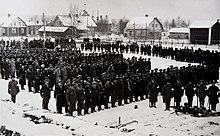
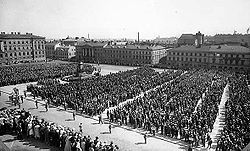

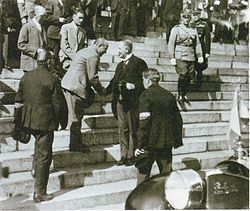
406) Lapuan liike, Lapporörelsen, Lapua Movement, Ruch Lapua - skrajnie prawicowy ruch polityczny w Finlandii na przełomie lat 20. i 30. XX wieku. Ruch Lapua powstał w 1929 roku. Zainicjowali go antykomunistyczni nacjonaliści, wywodzący się z Białych Finów z okresu fińskiej wojny domowej. Pod koniec listopada 1929 r. w Lapua doszło do zjazdu młodzieżowej organizacji komunistycznej, co doprowadziło do silnego sprzeciwu miejscowych antykomunistów. 1 grudnia odbyli oni swój zjazd, na który przybyło ponad 1 tys. ludzi. Zażądali delegalizacji wszelkich organizacji komunistycznych. W całym kraju miały miejsce liczne wiece, marsze i demonstracje o charakterze antykomunistycznym. Doprowadziło to do powstania Ruchu Lapua. Na jego czele stanęli Vihtori Kosola i szef sztabu armii fińskiej gen. Kurt Martti Wallenius. Pierwsze działania zostały wymierzone przeciwko drukarniom wydającym komunistyczne gazety. W poł. czerwca 1930 r. ponad 3 tys. działaczy przybyło do Oulu, aby zniszczyć drukarnię i biuro gazety "Pohjan Voima". Władze zdążyły jednak kilka dni wcześniej zabronić jej wydawania. W tym samym czasie spalono komunistyczną drukarnię w Vaasa. Na pocz. lipca miał miejsce tzw. marsz chłopski na Helsinki, w który wzięło udział ponad 12 tys. ludzi, aby zademonstrować rządowi siłę Ruchu. Lappiści wdarli się do gmachu parlamentu i wywlekli stamtąd 2 deputowanych komunistycznych. Przestraszone władze wydały przepisy, delegalizujące komunistyczne wydawnictwa, a także pozbawiające immunitetu komunistycznych deputowanych, którzy zostali aresztowani. Następnie zdelegalizowały działalność partii komunistycznej i rozwiązały parlament. Jednocześnie odbyły się przyśpieszone wybory parlamentarne, a następnie prezydenckie, które wygrała prawica. Wkrótce potem doszło do kilku morderstw na działaczach komunistycznych, które oficjalnie nie zostały wyjaśnione. Ulubioną metodą lappistów było porywanie działaczy komunistycznych, lewicowych lub związkowych, i pobitych odstawianie pod granicę z ZSRR, ewentualnie wyrzucanie na drugą stronę granicy. 14 października został wraz z żoną porwany b. prezydent Kaarlo Juho Ståhlberg. Został on następnie pobity i przewieziony do Joensuu. Po pewnym czasie zwolniono go. Władze aresztowały gen. K. M. Walleniusa, ale został uwolniony od wszelkich podejrzeń i zwolniony. Z Ruchem sympatyzowało początkowo wielu polityków i wyższych wojskowych, gdyż antykomunizm był bardzo rozpowszechniony po wygranej wojnie domowej. Lappistów chwalili publicznie gen. Carl Gustaf Mannerheim i jako jeszcze premier Pehr Evind Svinhufvud. Narastający ekstremizm i wzorowanie się na faszyzmie (czarne koszule jako ubiór członków Ruchu) doprowadziły jednak do zdecydowanego osłabienia poparcia społecznego. W lutym 1932 r. bojówkarze Ruchu zaatakowali zjazd socjaldemokratów w Mäntsälä. Przerodziło się to w próbę zamachu stanu, kierowaną przez gen. K. M. Walleniusa, zwaną rebelią w Mäntsälä. Lappistom udało się przejąć władzę w kilku miejscowościach. Początkowo rząd podjął pertraktacje z nimi, rozważając powierzenie stanowiska premiera jednemu z przywódców Ruchu. Ostatecznie jednak postanowił przystąpić do konfrontacji. Pomimo apeli gen. K. M. Walleniusa armia w większości pozostała wierna władzom. Po odezwie wygłoszonej w radio przez nowego prezydenta P. E. Svinhufvuda, popieranego na początku przez lappistów, pucz został zakończony. Kilkudziesięciu działaczy zostało aresztowanych i skazanych na kary więzienia, zaś Ruch zdelegalizowano 21 listopada 1932 r. Zostały do tego wykorzystane te same przepisy, na podstawie których rozwiązano partię komunistyczną. Wielu jego członków kontynuowało działalność w ramach nowo utworzonego Patriotycznego Ruchu Ludowego. Pod wpływem Ruchu Lapua ukształtował się na przełomie 1929 i 1930 r. w Estonii, kombatancki, antykomunistyczny i antyparlamentarny ruch Wabsów (Związek Uczestników Wojny Wyzwoleńczej). Nazwa Lapuan liike pochodzi od fińskiego miasta Lapua (szw. Lappo) i oznacza ruch z (miasta) Lapua. Członków ruchu nazywano Lappowcami.
0 notes
Photo
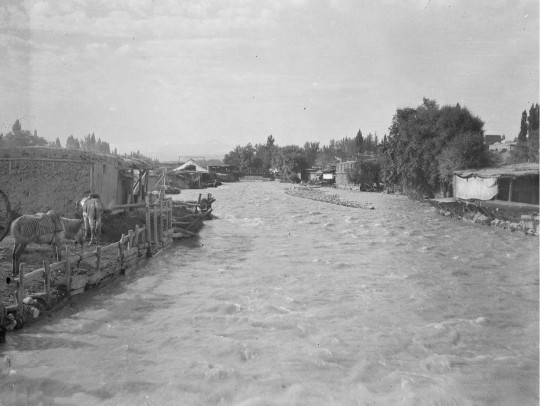
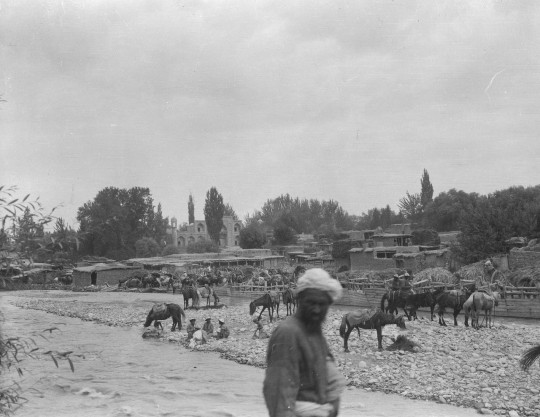
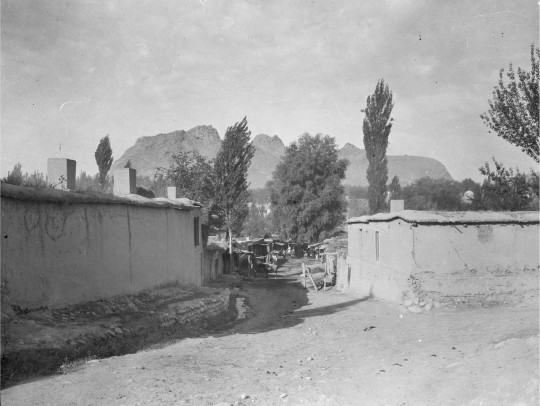
Osh, Kyrgyzstan, photographed by Carl Gustaf Emil Mannerheim, 1906 (source)
24 notes
·
View notes
Link
[thien_display_title] Trendy Fashion Style Gearhomies Unisex Hawaiian Shirt Carl Gustaf Emil Mannerheim Historical 3D Apparel is a perfect shirt to show your patriotism. Featured on this shirt is the portrait of Carl Gustaf Emil Mannerheim, the Finnish Field Marshal and Commander in Chief of the Armed Forces of Finland during World War II, and the National Emblem of Finland. The shirt comes in sizes for men and women, and is made of 100% cotton for comfortable wear. Gearhomies Unisex Hawaiian Shirt Carl Gustaf Emil Mannerheim Historical 3D Apparel 100% Comfortable Cotton, Amazing Printing and Design We have created a shirt that is both comfortable and stylish. Carl Gustaf Emil Mannerheim is the most renowned general in Finnish history and this shirt pays tribute to him. The shirt is made out of 100% comfortable cotton and has amazing printing and design. It's a hot trend and perfect for any sale customer. Gearhomies Unisex Hawaiian Shirt Carl Gustaf Emil Mannerheim Historical 3D Apparel is a must-have for all sale customers. This Hawaiian shirt is made of 100% cotton and features a detailed depiction of General Carl Gustaf Emil Mannerheim on the front. The shirt is available in various colors, so you can find the perfect one for you. This top is perfect for any casual event or beach vacation. [thien_display_title] Information: KEY FEATURES: Hawaiian shirts are great for outdoor activities like camping and beach vacations.. The lightweight fabric makes your casual wardrobe essential ideal for everyday wear. The ideal for celebrations and special occasions like: Birthdays, Housewarming gifts... PRODUCT INFORMATION: 100% woven polyester fabric, offers outstanding durability, insulation, and wrinkle resistance. Machine wash in cold with similar colors/no bleach/low iron About Shirts: Regular fit, lightweight, button-down closure all over printing shirt featuring spread collar and short sleeve. About Shorts: Flat-front casual all over printing short with side pockets, mid rise, elastic waistband. The elastic, breathable material makes it ideal for outdoor activities. PRINT: Dye-sublimation printing Care instructions: Machine wash cold, only non-chlorine bleach when needed, hang dry, cool iron on the reverse side or dry clean NOTE: - Since the size is manually measured, please allow a slight dimension difference from 1-3 cm. - Due to the different monitor and light effect, the actual colour of the item might be slightly different from the visual pictures. [thien_display_attachment_images] Our Social: Pinterest, Twitter From: Haotechcom Store
0 notes
Text
8/1
Another comedy
The dinner we ate that all up right away
A water biscuit
A water plant
A pepper leaf
A gamey whip
And then childhood
Traditional mix of wedding and market
Rapid gasket
Famous brothers
Carl and Gustaf Mannerheim
Sunk money into the creeping feeling
Under number 277
While Karl the younger taxonomist
Wrote a note that went unread
8/1
Sailors named the underbelly hardtack
Just as whatever left leaves underway
I’ve lost friends by failing to mention surplus
And societies got wet in the rush to undo what had been done
Magic can be religious or intuitive
It is only some manipulation of the spirits
A common source of marvelous containment
A barren tree, barking dogs, or any true effort to yield a fruitful crop
0 notes
Text

June 4
[1039] Holy Roman Emperor, Conrad II died.
[1615] The fortress at Osaka Japan, fell to Shogun Leyasu after a 6-month siege.
[1647] Parliamentary forces captured King Charles I and held him prisoner.
[1717] The Freemasons were founded in London.
[1738] King of Great Britain, George III was born.
[1783] The Montgolfier brothers demonstrated the first hot-air balloon.
[1792] British General, John Burgoyne died.
[1794] British troops captured Port-au-Prince, Haiti.
[1796] Napoleon Bonaparte commanded the Siege of Mantua, which resulted in the exclusions of Austrians from Northern Italy.
[1798] Italian adventurer, Giacomo Casanova died.
[1798] Irish rebel, Lord Edward Fitzgerald died.
[1867] President of Finland, Carl Gustaf Mannerheim was born.
[1887] Vice President of the U.S., William A. Wheeler died.
[1895] Italian official, Dino Grandi, conte di Mordano was born
[1895] Sultan of Johore, Abu Bakar died.
[1911] Gold was discovered in Alaska's Indian Creek.
[1917] The first Pulitzer Prize was awarded.
[1918] Vice President of the U.S., Charles Warren Fairbanks died.
[1919] The 19th Amendment to the U.S. Constitution, which gave women the right to vote, was passed by the Senate, two weeks after being approved by the House of Representatives.
[1920] The Treaty of Trianon was signed by representatives of Hungary on one side and the Allied powers on the other, concluding World War I.
[1937] The world's first shopping carts were introduced at Humpty Dumpty grocery stores in Oklahoma City, Oklahoma.
[1940] Dunkirk evacuation ended.
[1941] Emperor of Germany, William II died.
[1942] Japan was repulsed by the United States at the Battle of Midway in World War II.
[1944] Allied troops liberated Rome.
[1945] United States, Soviet Union, Britain and France agreed to divide up occupied Germany.
[1952] President of Poland, Bronisław Komorowski was born.
[1970] The Kingdom of Tonga achieved independence within the British Commonwealth.
[1989] Thousands died in the Tiananmen Square Massacre.
[1989] Poland held the first free elections after World War II.
#on this day#otd#on this day in history#birthdates#death dates#american history#june#world history#history
0 notes